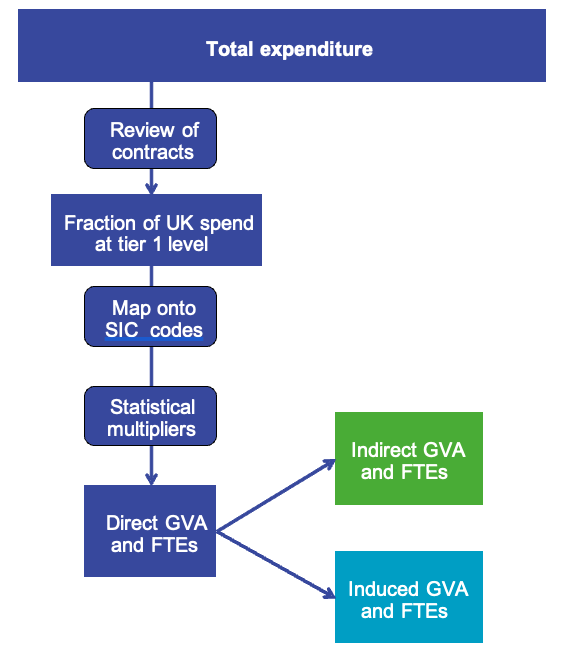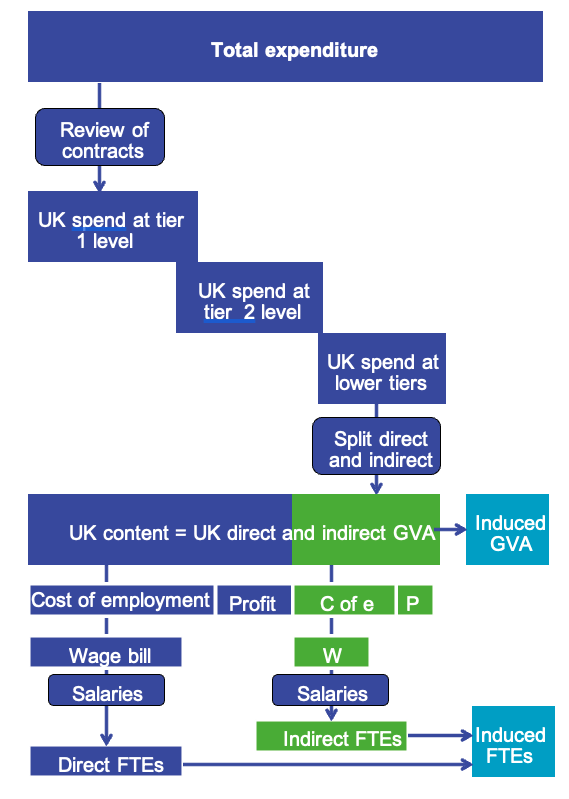Scenario mapping for offshore renewable energy development economic benefits: case studies
Report to identify, measure and value the delivered and potential economic impact for Scotland from offshore wind and tidal energy projects.
Appendix B: Economic impact assessment methodology
Conventional modeling of economic impacts for most industrial sectors relies on government statistics, for example those based on Standard Industry Classification (SIC) codes and use input-output tables and other production and employment ratios, for example those produced by the Office of National Statistics or the Scottish Government.
SIC code data can be appropriate for traditional industries at a national level. The development of new codes for a maturing sector, however, takes time. This means that conventional SIC analyses of offshore wind need to map existing NAICS data onto offshore wind activities, which is not easy and a source of error. Analyses using SIC codes also have to rely on generalised data.
Offshore wind is ideally suited to a more robust approach that considers current and future capability of local supply chains because:
- Projects tend be large and have distinct procurement processes from one another, and
- Projects tend to use comparable technologies and share supply chains.
- It therefore enables a realistic analysis of the local, regional and national content of projects even where there are gaps in the data.
The methodology used here was developed by BVGA and has been used for a series of major clients.
The methodology’s first input is the cost per MW of each of the supply chain categories at the time of wind farm completion.
The remaining expenditure is analogous to the direct and indirect gross value added (GVA) created. GVA is the aggregate of labour costs and operational profits. We can therefore model full time equivalent (FTE) employment from GVA, provided we understand some key variables. In our economic impact methodology, employment impacts are calculated using the following equation:
FTEa = (GVA - M)/(Ya + Wa)
Where:
FTEa = Annual FTE employment
GVA = Gross value added (£)
M = Total operating margin (£)
Ya = Average annual wage (£), and
Wa = Non-wage average annual cost of employment (£).
To make robust assessments, therefore, we consider each major component in the offshore wind supply chain and estimate typical salary levels, costs of employment and profit margins, bringing together BVGA’s specific sector knowledge and research into typical labor costs for the work undertaken in each supply chain level 2 category.
The impacts in this report relate to Scotland as a whole or to local areas within Scotland. Employment, earnings and GVA all relate to places of work within Scotland.
FTEs relate to full time equivalent job years, with part-time or part-year work taken into account as appropriate. A full-time job would normally be at least 7 hours per day over c230 working days of the year. If an individual works significantly more than this over a year, FTE attribution would be more than 1 FTE (e.g. 1.5 FTEs if working long hours over 7 days per week).
FTEs in the report are by workplace rather than by residence and will include migrant/temporarily resident workers.
Where work in a local area (e.g. on an assembly site) is carried out by people who have been brought there from elsewhere in the UK or overseas and live in temporary accommodation while working on site, their daily expenditures on accommodation, food & drink, leisure, etc create employment impacts locally and within Scotland more widely. These impacts have been taken into account in the indirect impacts because these payments are likely to be covered through subsistence expenses rather than personal expenditure.
The GVA to gross earnings ratio for a business can be relatively high where it is charging for use of expensive plant, equipment, boats, etc. Where a specialist vessel, for example, has been built in Scotland for offshore renewables work, the prior employment and earnings impacts from this could be additional to what it has been possible to capture in the analysis carried out for this report
In this report, GVA and earnings impacts have not been discounted.
Comparison with conventional economic impact methodologies

In a conventional analysis, multipliers are used that are based on statistics of expenditure flows in different sectors. Once the analysis has established what contracts have been awarded to companies in the UK, the contractors are associated with one of more sectors used in the Standard Industry Classification. Input-output tables created, for example, by the Scottish Government are used to develop multipliers. These multipliers are used to calculate how demand in each of the SIC sectors leads to direct, indirect and induced impacts.

The multipliers used in conventional analysis in effect ignore the supply chain in detail, assuming that sector statistics are valid. The BVGA method is based on the offshore wind UK content methodology that seeks to understand the supply chain in the lower tiers and produces a figure that is equivalent to direct and indirect GVA. Calculating a UK content figure, and having an understanding of profit margins, costs of employment and salaries enables direct and indirect FTEs to be calculated. Induced impacts are calculated using conventional multipliers. The same methodology is followed for Scottish and local content.
Contact
Email: ScotMER@gov.scot
There is a problem
Thanks for your feedback